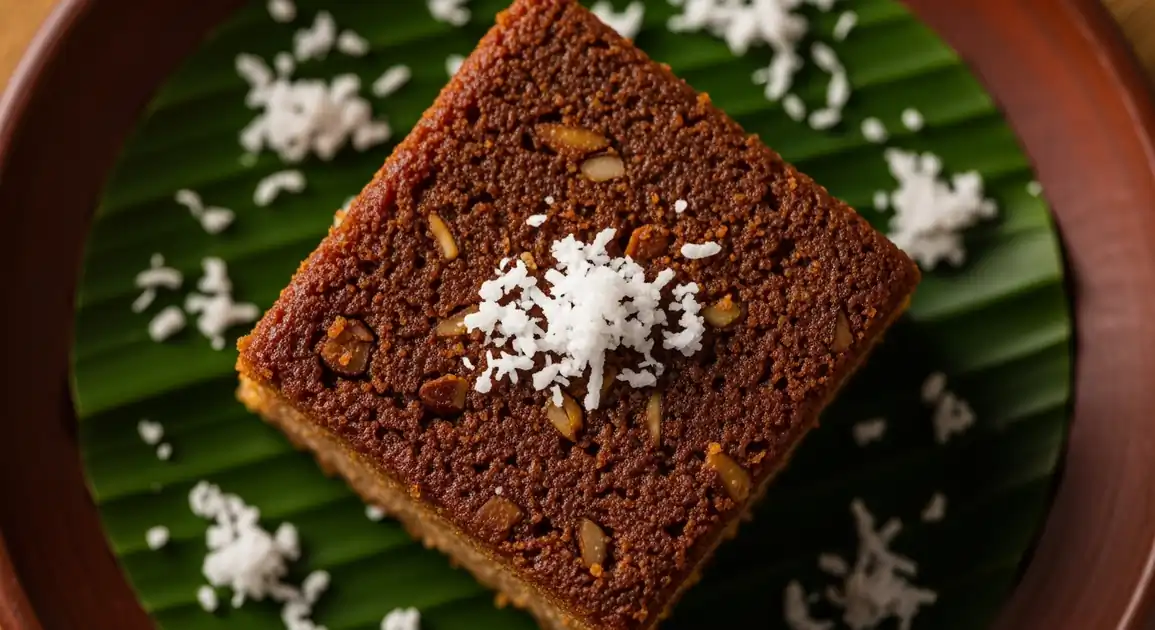Bibikkan (Coconut Cake)
බිබික්කන්

Description
In Galle, particularly within and around the historic Fort area, Bibikkan reflects both traditional Sri Lankan techniques and subtle colonial influences from the Dutch and Portuguese eras. Galle's coastal location ensures access to fresh coconut, while the region's historical spice trade legacy means local versions often feature carefully balanced spice profiles.
Dietary Information
Serving information
Serving style
In traditional bakeries, wrapped in paper or banana leaf. Tourist cafés often serve on plates, sometimes with vanilla ice cream or cream as a fusion dessert. Home-style versions may be accompanied by a small pot of kithul treacle on the side.
Quick facts
Local bakeries: 6 AM - 8 PM. Fort area establishments: 8 AM - 9 PM, with some cafés open until 10 PM. Market vendors: 6 AM - 2 PM, busiest on designated market days.
Safety Tips
What to Look For
-
Moist, slightly sticky texture
Quality Bibikkan should be moist throughout. Dry or hardened edges indicate it's old or poorly stored.
-
Even, dark brown color
The color should be consistently deep brown from the treacle. Unevenly colored pieces may be improperly baked.
-
Covered display
Vendors who keep their Bibikkan in covered displays protect it from insects and environmental contaminants.
-
Clean cutting implements
When the vendor cuts a piece, their knife or spatula should be clean, not sticky with residue from other sweets.
-
Noticeable spice aroma
Fresh Bibikkan has a distinct aroma of cardamom, cinnamon, and cloves alongside coconut.
What to avoid
-
Dried out or hardened pieces
Excessively dry Bibikkan is likely old. Besides affecting taste, it may indicate poor storage practices.
-
Mold or unusual discoloration
Despite its preservative ingredients, Bibikkan can develop mold if stored improperly in humid conditions.
-
Open displays in dusty or insect-prone areas
Uncovered sweets in busy markets or street-side stalls can collect contaminants.
-
Strong fermented smell
A fermented or alcohol-like smell suggests the coconut has begun to spoil.
-
Excessive sugar crystals on the surface
While a slight sugar sheen is normal, excessive crystallization suggests poor quality ingredients or improper preparation.
Price information
Price range
Budget tips
- Prices vary significantly between the Fort area (higher, 200-450 LKR) and local areas outside the tourist zones (lower, 75-200 LKR).
- Small bakeries on side streets outside Galle Fort offer better value than those within the walls.
- Morning purchases at local bakeries often secure the freshest pieces at standard prices.
- Some vendors offer bulk discounts when purchasing multiple pieces.
- The Galle central market (pola) has competitive prices, especially early in the day.
Value indicators
- Freshness indicated by moist texture and strong aroma.
- Dark color suggesting proper treacle content.
- Visible inclusion of quality spices and fresh coconut.
- Clean, precise cutting into generously sized pieces.
- Proper wrapping to maintain moisture and freshness.
Where to Find This Dish
Galle Fort
Historic UNESCO area with both traditional and upscale bakeries catering to tourists and locals.
Dutch Reformed Church, Lighthouse, Rampart Street
Afternoon, Evening
Galle Town Center
Commercial hub with numerous local bakeries offering authentic versions at lower prices.
Galle Central Market, Main Bus Station, Clock Tower
Morning, Afternoon
Unawatuna Beach Area
Tourist zone with cafés offering both traditional and modified fusion versions.
Beach Road, Jungle Beach Turn, Thalagaha Junction
Afternoon, Evening
Vendor Tips
- Fort area bakeries may charge premium prices but often maintain high quality for discerning tourists.
- Bakeries displaying 'homemade' or 'traditional' signs often create smaller batches with better quality control.
- Ask locals for recommendations – taxi drivers and guesthouse owners often know the best-kept secrets.
- Some places offer taste samples – a good vendor will be proud to demonstrate their quality.
How to Order
Regional Variations
-
Galle Fort Bibikkan
(ගාලු කොටුවේ බිබික්කන්)
Versions found within the historic Fort area often feature more precise spice balances and presentation, sometimes with subtle Dutch influences like added vanilla or almond.
-
Coastal Bibikkan
(වෙරළබඩ බිබික්කන්)
Prepared in villages along Galle's coastline, often featuring extra coconut and sometimes incorporating a hint of sea salt for depth of flavor.
-
Market Fresh Bibikkan
(පොළ බිබික්කන්)
Versions sold at the Galle central market tend to be more rustic and traditional, often made by home bakers from surrounding villages using family recipes.
-
Luxury Bibikkan
(සුපිරි බිබික්කන්)
Upscale versions found in boutique hotels and high-end restaurants within Galle Fort, often featuring premium ingredients like first-press kithul treacle and organic spices.
Cultural context
History
Bibikkan originated in southern coastal regions of Sri Lanka, where coconut palms and kithul (fishtail palm) trees thrive. It evolved as a practical preservation method for abundant coconut harvests, using jaggery as both flavoring and preservative. Traditionally prepared for special occasions and Sinhalese New Year celebrations, Bibikkan reflects Sri Lanka's historical connection to spice trading, incorporating valuable aromatics like cardamom and cloves. Over time, it transitioned from a ceremonial treat to an everyday sweet enjoyed throughout the country.
Local significance
In Galle, Bibikkan represents the region's rich culinary heritage influenced by indigenous Sinhalese traditions and colonial Dutch and Portuguese elements. Local pride in high-quality kithul treacle production influences the distinctive flavor of Galle's Bibikkan.
Eating customs
- In Galle, often enjoyed as an afternoon snack with Ceylon tea.
- Local families may serve it to guests as a symbol of hospitality.
- In upscale establishments within the Fort, sometimes served warm with vanilla ice cream as a fusion dessert.